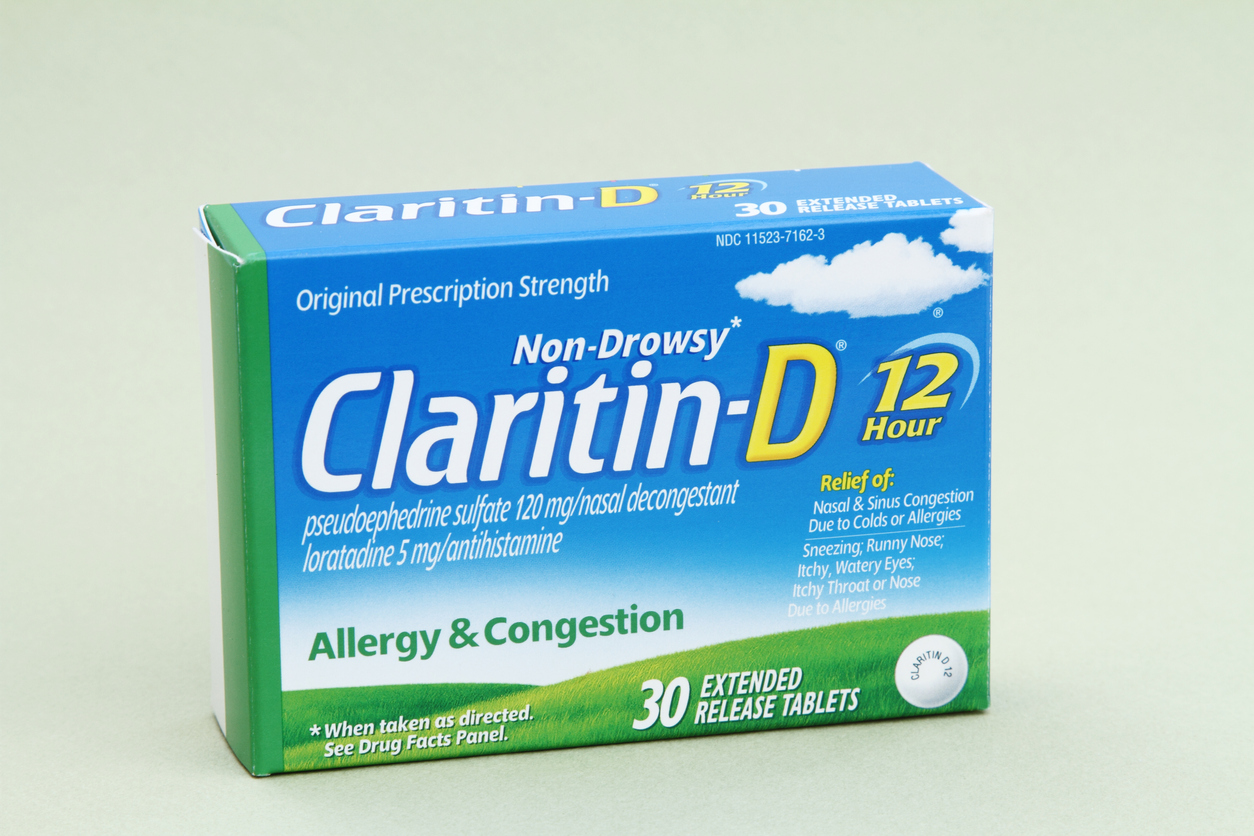Loratadine (Claritin): Side Effects and Interactions

The Bottom Line
Loratadine (Claritin®) is an over-the-counter medicine used to relieve allergy symptoms. It is typically well-tolerated with minimal side effects such as headache and minor drowsiness, but generally doesn’t cause significant tiredness. There are minimal drug interactions associated with loratadine. Loratadine is typically safe to use during pregnancy and lactation.

What is loratadine (Claritin)? Is Claritin an antihistamine?
Loratadine (Claritin) is an antihistamine that is typically used for allergy symptoms such as sneezing, itchy eyes, stuffy nose (congestion), and runny nose. While loratadine can help treat stuffy nose symptoms, it is not a decongestant. However, Claritin-D over-the-counter products do contain the decongestant pseudoephedrine, so it is important to check the label for active ingredients when choosing an allergy medication.
What are the side effects of loratadine?
Loratadine is a well-tolerated medication with minimal side effects. Some of the main side effects of loratadine are headache and drowsiness. Loratadine itself does not typically increase blood pressure, but if used in combination with pseudoephedrine (for example, as Claritin-D), an increase in blood pressure can occur. While loratadine causes less drowsiness than other allergy medicines, it can still cause sleepiness in some individuals. Children who take loratadine may experience side effects, including headaches, fatigue, and nervousness.
Zyrtec vs. Claritin vs Allegra: What are the differences?
While cetirizine (Zyrtec®), loratadine (Claritin®), and fexofenadine (Allegra®) are all allergy medicines and second-generation antihistamines, there are differences between them. The second generation antihistamines cause less tiredness than first generation antihistamines such as diphenhydramine (Benadryl). Cetirizine does cause some drowsiness as a side effect, while fexofenadine and loratadine generally do not. Depending on the formulation, fexofenadine may be taken once or twice daily, while cetirizine and loratadine are typically taken once daily. Because of how it is processed by the body, fexofenadine’s efficacy can be affected by high-fat meals and grapefruit juice. Overall, however, all three medications are similarly effective in relieving allergies.
Can you take Claritin and Benadryl together? Loratadine interactions and what not to take with Claritin.
It is not recommended to take diphenhydramine (Benadryl) and loratadine (Claritin) together as there is an increased risk for side effects such as dry mouth, dry eyes, constipation (infrequent bowel movements), and drowsiness. In addition, do not take loratadine (Claritin) while taking erythromycin (an antibiotic), ketoconazole (an antifungal drug), cimetidine (a heartburn medicine), or clarithromycin (an antibiotic) due to potential drug interactions and an increased risk of side effects.
There is no drug interaction between pseudoephedrine and loratadine, but medicines such as Claritin-D contain both loratadine and pseudoephedrine, so be sure to check the ingredients before combining medications. Fluticasone (Flonase) and loratadine (Claritin) are sometimes used together for relieving allergies and do not have any significant drug interactions. Ibuprofen and loratadine can be used together as well. Unlike fexofenadine (Allegra), it is generally safe to consume loratadine with grapefruit juice.
Can you take loratadine when pregnant or breastfeeding?
Loratadine can be used during pregnancy and is not associated with pregnancy-related issues or birth defects. Loratadine is also generally safe to use during lactation. Small amounts of loratadine can transfer into human milk, but the infant receives less than 1% of the maternal dose. This low amount should not cause serious harm to infants, but may cause irritability or drowsiness in some cases.
I accidentally took 20 mg of loratadine. What should I do?
The maximum recommended dose of loratadine is 10 mg taken once daily. Taking more than the maximum dose may result in increased side effects such as tiredness or headache. If someone develops unexplained or unexpected symptoms after taking loratadine, or if too much was taken, get guidance from Poison Control immediately. Help from Poison Control is available at www.poison.org and by phone at 1-800-222-1222. Both options are free, confidential, and available 24 hours a day.
Written by:
Jordan Manno, PharmD
Medically reviewed by:
Kelly Johnson-Arbor, MD
Medical Toxicologist
Poisoned?
Call 1-800-222-1222 or
Prevention Tips
- Take medications only as directed.
- Store loratadine out of reach of children.
- Read the ingredients list before combining allergy medications, to avoid unwanted side effects.
This Really Happened
Case 1: An 18-year-old woman ingested 300 mg of loratadine. She went to a hospital, where she was found to have elevated blood pressure, a rapid heart rate and breathing rate, and dry, flushed skin. She was given activated charcoal and admitted to the hospital for observation. She gradually recovered and was discharged two days later.
Case 2: A 6-year-old boy ingested 300 mg of loratadine. The child only experienced a slight increase in blood pressure and heart rate, and no significant treatment was needed
For More Information
References
Poisoned?
Call 1-800-222-1222 or
Prevention Tips
- Take medications only as directed.
- Store loratadine out of reach of children.
- Read the ingredients list before combining allergy medications, to avoid unwanted side effects.
This Really Happened
Case 1: An 18-year-old woman ingested 300 mg of loratadine. She went to a hospital, where she was found to have elevated blood pressure, a rapid heart rate and breathing rate, and dry, flushed skin. She was given activated charcoal and admitted to the hospital for observation. She gradually recovered and was discharged two days later.
Case 2: A 6-year-old boy ingested 300 mg of loratadine. The child only experienced a slight increase in blood pressure and heart rate, and no significant treatment was needed
